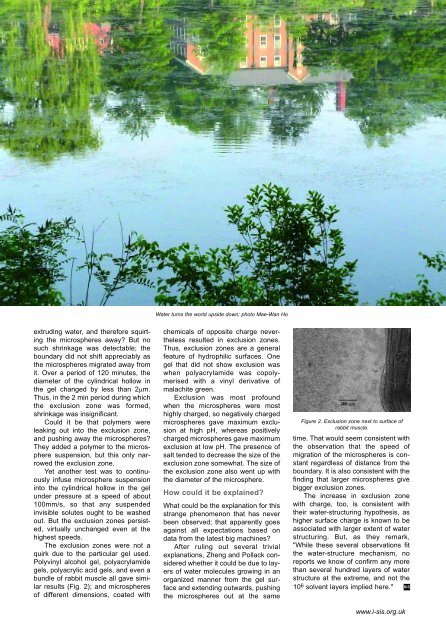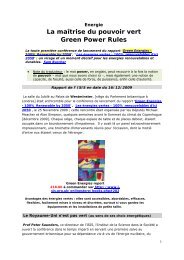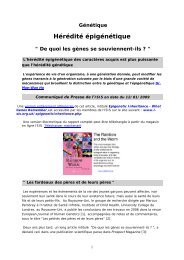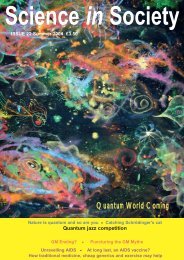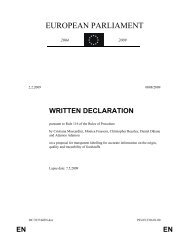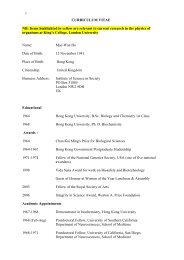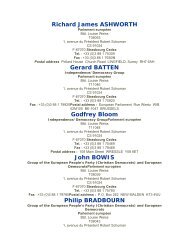Ethiopia goes organic to feed herself - The Institute of Science In ...
Ethiopia goes organic to feed herself - The Institute of Science In ...
Ethiopia goes organic to feed herself - The Institute of Science In ...
You also want an ePaper? Increase the reach of your titles
YUMPU automatically turns print PDFs into web optimized ePapers that Google loves.
Water turns the world upside down; pho<strong>to</strong> Mae-Wan Ho<br />
extruding water, and therefore squirting<br />
the microspheres away? But no<br />
such shrinkage was detectable; the<br />
boundary did not shift appreciably as<br />
the microspheres migrated away from<br />
it. Over a period <strong>of</strong> 120 minutes, the<br />
diameter <strong>of</strong> the cylindrical hollow in<br />
the gel changed by less than 2µm.<br />
Thus, in the 2 min period during which<br />
the exclusion zone was formed,<br />
shrinkage was insignificant.<br />
Could it be that polymers were<br />
leaking out in<strong>to</strong> the exclusion zone,<br />
and pushing away the microspheres?<br />
<strong>The</strong>y added a polymer <strong>to</strong> the microsphere<br />
suspension, but this only narrowed<br />
the exclusion zone.<br />
Yet another test was <strong>to</strong> continuously<br />
infuse microsphere suspension<br />
in<strong>to</strong> the cylindrical hollow in the gel<br />
under pressure at a speed <strong>of</strong> about<br />
100mm/s, so that any suspended<br />
invisible solutes ought <strong>to</strong> be washed<br />
out. But the exclusion zones persisted,<br />
virtually unchanged even at the<br />
highest speeds.<br />
<strong>The</strong> exclusion zones were not a<br />
quirk due <strong>to</strong> the particular gel used.<br />
Polyvinyl alcohol gel, polyacrylamide<br />
gels, polyacrylic acid gels, and even a<br />
bundle <strong>of</strong> rabbit muscle all gave similar<br />
results (Fig. 2); and microspheres<br />
<strong>of</strong> different dimensions, coated with<br />
chemicals <strong>of</strong> opposite charge nevertheless<br />
resulted in exclusion zones.<br />
Thus, exclusion zones are a general<br />
feature <strong>of</strong> hydrophilic surfaces. One<br />
gel that did not show exclusion was<br />
when polyacrylamide was copolymerised<br />
with a vinyl derivative <strong>of</strong><br />
malachite green.<br />
Exclusion was most pr<strong>of</strong>ound<br />
when the microspheres were most<br />
highly charged, so negatively charged<br />
microspheres gave maximum exclusion<br />
at high pH, whereas positively<br />
charged microspheres gave maximum<br />
exclusion at low pH. <strong>The</strong> presence <strong>of</strong><br />
salt tended <strong>to</strong> decrease the size <strong>of</strong> the<br />
exclusion zone somewhat. <strong>The</strong> size <strong>of</strong><br />
the exclusion zone also went up with<br />
the diameter <strong>of</strong> the microsphere.<br />
How could it be explained?<br />
What could be the explanation for this<br />
strange phenomenon that has never<br />
been observed; that apparently <strong>goes</strong><br />
against all expectations based on<br />
data from the latest big machines?<br />
After ruling out several trivial<br />
explanations, Zheng and Pollack considered<br />
whether it could be due <strong>to</strong> layers<br />
<strong>of</strong> water molecules growing in an<br />
organized manner from the gel surface<br />
and extending outwards, pushing<br />
the microspheres out at the same<br />
Figure 2. Exclusion zone next <strong>to</strong> surface <strong>of</strong><br />
rabbit muscle.<br />
time. That would seem consistent with<br />
the observation that the speed <strong>of</strong><br />
migration <strong>of</strong> the microspheres is constant<br />
regardless <strong>of</strong> distance from the<br />
boundary. It is also consistent with the<br />
finding that larger microspheres give<br />
bigger exclusion zones.<br />
<strong>The</strong> increase in exclusion zone<br />
with charge, <strong>to</strong>o, is consistent with<br />
their water-structuring hypothesis, as<br />
higher surface charge is known <strong>to</strong> be<br />
associated with larger extent <strong>of</strong> water<br />
structuring. But, as they remark,<br />
"While these several observations fit<br />
the water-structure mechanism, no<br />
reports we know <strong>of</strong> confirm any more<br />
than several hundred layers <strong>of</strong> water<br />
structure at the extreme, and not the<br />
10 6 solvent layers implied here." SiS<br />
www.i-sis.org.uk


